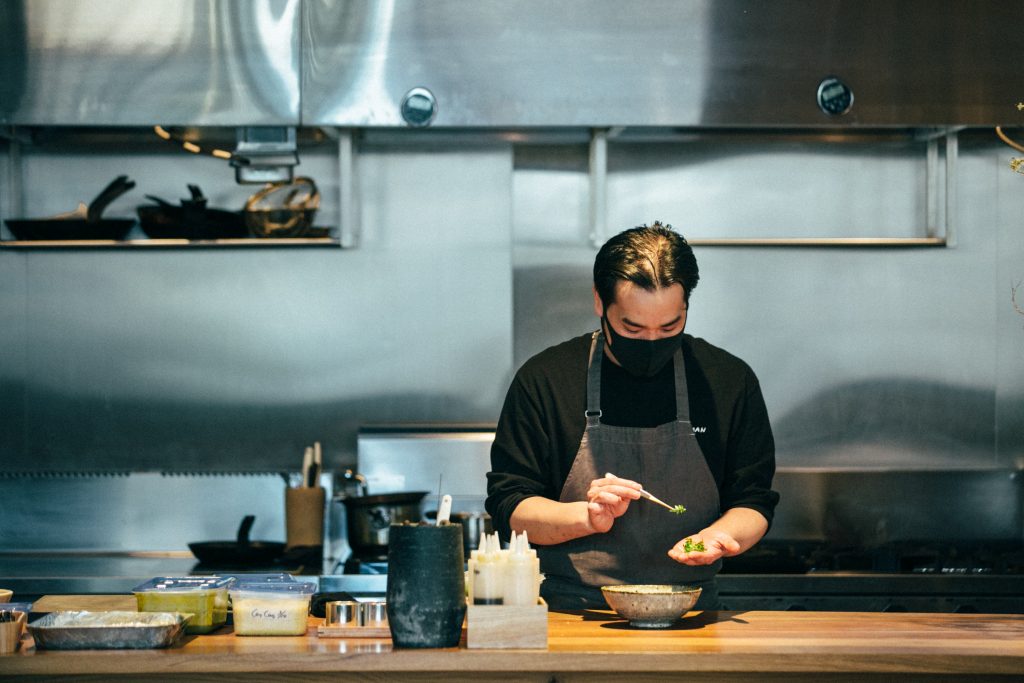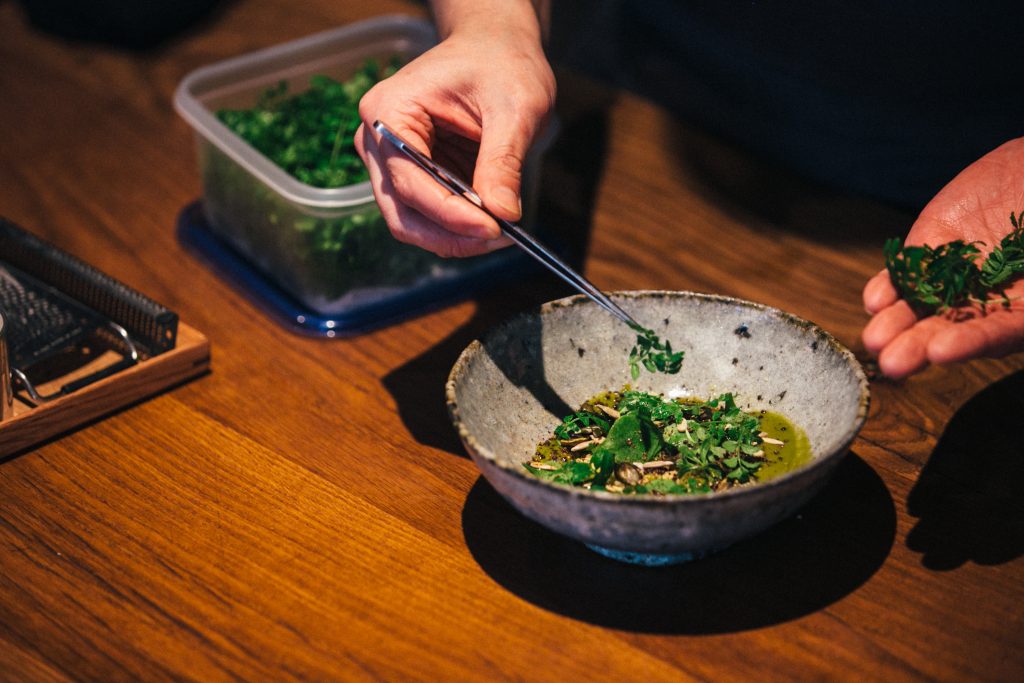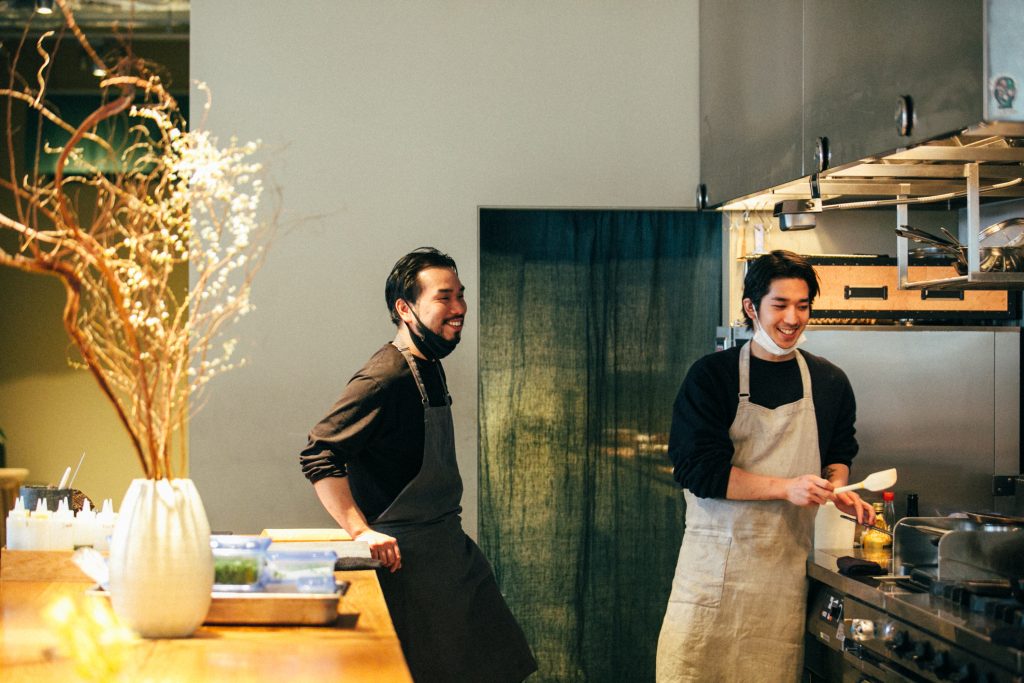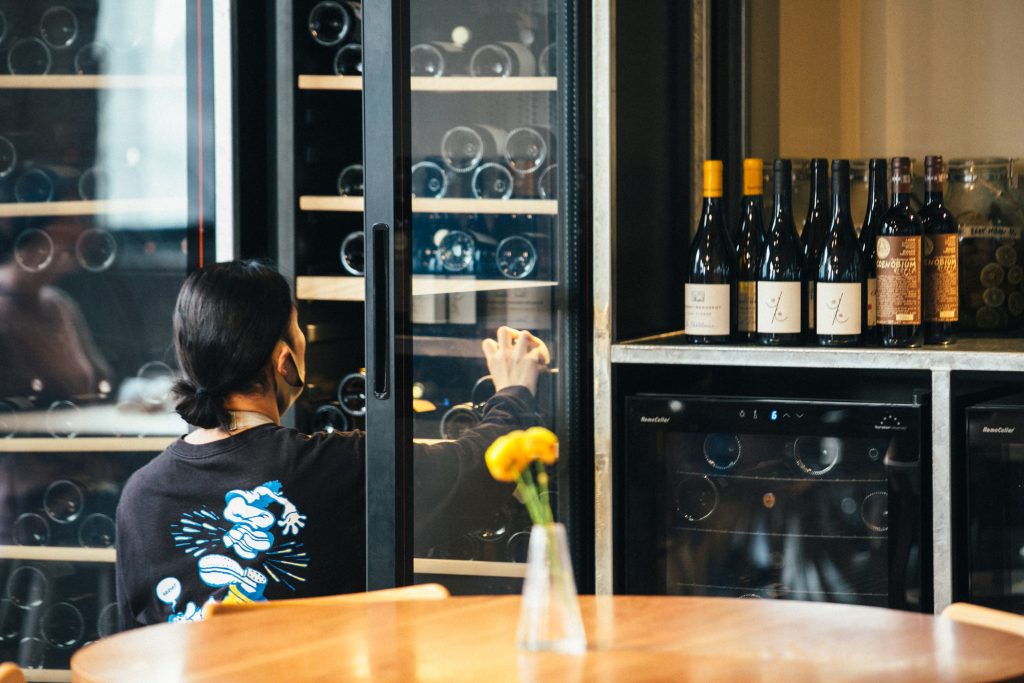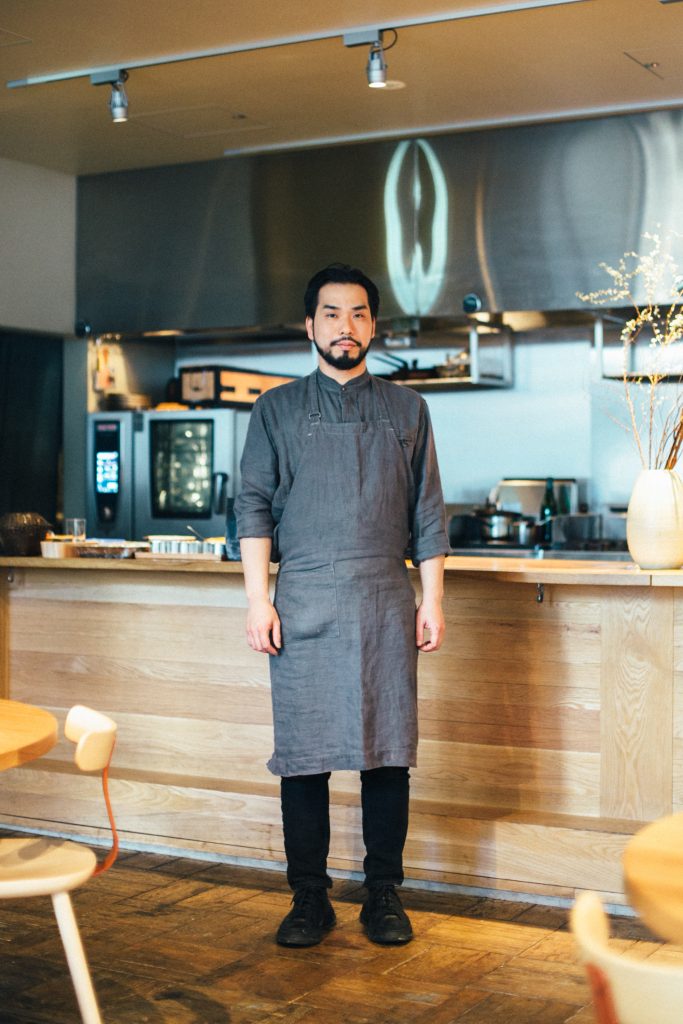


The bitterness of beer and the sourness of ants
Cooking beyond observation and imagination
●When did you start cooking?
When I was 18 years old I graduated from high school and enrolled in a cooking school. The school was called Tsuji Culinary Institute, located in Tennoji, Osaka, so I had to move there; it was my first time living alone. I also studied for a year at a well-known school here in Tokyo, and by the time I turned 19, I began working at Ponte Vecchio, an Italian restaurant with a reputation for being the best in Kansai. There were only 20 new graduate positions, including kitchen and service staff, and around 100 people would fight for those spots. There were written tests on the Italian language, geography, and culinary techniques, as well as an interview. In addition to my test score, I was lucky enough to work at the main restaurant, where only four people are assigned. Perhaps it was because the owner-chef and I were both born in Neyagawa, Osaka.
That’s when the hard part started. Especially during the first year, there were a lot of chores, and we weren’t even allowed to touch the fish. First thing in the morning, I had to refill the olive oil and pepper mills, wash the towels, and roast the salt in the oven. This was to prevent the salt from getting stuck on the chef’s fingers because Japan is very humid. I worked from 7 a.m. through to 1 a.m. the next morning, doing prep work and baking. After my second year, I started working from 10 a.m. and things began to settle down a bit. I ended up working there for about six years.
●What did you get out of it?
I was only 19 years old so there were a lot of things I didn’t understand, but I learned about hierarchy and once I had juniors working below me, I learned how to teach others. There is a method called “optimal cooking” where the chef selects the best cooking method for a certain ingredient and brings out the flavor of that ingredient. The chef then consults with everyone to figure out how to make it taste good. Through this, I gradually learned how to boil, bake, and cut the food in the best way possible.
●When did you go to Italy?
When I was 24 years old. Seeing as I was pursuing Italian cuisine, I thought of it as unnatural not to go to Italy. Maybe you can already tell, but I chose Italian cuisine partly because I wanted to be popular with the girls (laughs). At the time it was popular so being able to cook pasta was pretty cool, you know? When I was in technical school, I also studied French and Japanese cuisine, but Italian cuisine had the most impact on me in terms of taste and it was easy to understand. French cuisine has too many kinds of sauces!
●What was your life like in Italy?
There is no working holiday visa in Italy, so you have to enrol in a language school. So, at first, I went to a language school in Florence, but after about a month and a half, I applied for a leave of absence and moved to the countryside of Piedmont, famous for its white truffles. It was my first time in the countryside of a foreign country. I couldn’t read the train schedules or understand what the cab drivers were saying. I was 25 years old and my first salary in Italy was about 400 Euros. I was allowed to live in the apartment above the restaurant, but after paying rent I only had 100 Euros left on which to live on. I switched to cheap hand-rolled cigarettes, and if I wanted to drink a beer or try something new or to eat at a certain restaurant, well I had to just be patient. I spent six months in Piedmont, and after that, I moved to Milan and Rome for six months apiece. In Milan, I worked at a famous Michelin-star restaurant. My salary was 700 euros, which was just enough to buy a panini and a beer at a street stall at night, but I still couldn’t get over the 100,000 yen barrier (laughs). When I was in Rome, my language skills finally improved and I was able to earn about 2,000 euros.
Above all, it is rich in nature, and it was refreshing to go into the mountains and forests and serve food to our customers that we had picked ourselves.
●What position did you work in Rome?
The restaurant was divided into three stations: meat, sauce, and vegetables. I was working in the meat station. At that point, I was finally getting used to the work, but Italians have a habit of not writing very neatly so it was hard for me to understand orders. For example, I would get orders for one risotto or one pasta, but they talked too fast for me to understand. In the kitchen, every second counts, so if I’m too slow, they would get angry at me. I hated that, so until my ears got used to the fast-paced language, I would always ask the Italian guy next to me, “What did they just say?”
●Was there anything in your life in Italy that you just couldn’t get used to?
First of all, the trains and buses are never on time. Once, I waited for two hours at a desolate bus station in Piedmont! Secondly, the mindset is quite rigid, especially in the countryside. Asians are a minority so I had to deal with a variety of situations. Some people got angry easily (laughs). However, it was a good experience to be able to learn about local traditional dishes. Those dish names and flavor combinations were completely new to me; something you would never find in restaurants in the city, and finally, I could taste them with my own tongue.
●How did you survive in the battlefield of the kitchen?
It was my first time working in a Michelin-star restaurant. There was no conversation during business hours. The only communication we had was when we drank beer together after the restaurant was closed. Looking back on it now, I think it was thanks to that time that I was able to continue. I originally went to Italy without studying the language, throwing away my textbooks along the way. So I learned the language on the go while talking with the locals. I learned the language on the spur of the moment, but now I’m slowly forgetting it.
●Why did you shift your interest to Scandinavian cuisine?
During my summer vacation in Italy, I traveled to Copenhagen and was so impressed by the New Nordic Cuisine I encountered at Kadeau that I decided to move to Scandinavia. Of course, Noma was doing very exciting things as well. Kadeau was a restaurant in Copenhagen, but they also had a restaurant on the island of Bornholm in the southeast Baltic Sea that was only open during the spring and summer. Shohei from Kabi (*1) was also working there at the time, so they let me work there for about two weeks. In the mornings, we would go into the forest and pick our own herbs, catch ants to make sauces, ferment, etc. I was so intrigued by the new experiences and cuisine that was so different to Italian cuisine, that I decided to move my base to Norway.
※1 Kabi
A restaurant in Meguro, Tokyo, created by the diverse cultures of Japan, France, and Denmark. Co-owned by chef Shohei Yasuda and sommelier Kentaro Emoto.
●What part of the New Nordic Cuisine movement fascinated you?
Scandinavia has a completely different climate compared to the rest of Europe. It is much colder and has its own unique flora. Above all, it is rich in nature, and it was refreshing to go into the mountains and forests and serve food to our customers that we had picked ourselves. We don’t usually eat ants, do we? We would go into the mountains in the morning to look for ant mounds. When we stuck a stick into an ant mound, the ants would climb up and release acid as a protection mechanism. There would be a sour smell that would fill the area and I would pull up my socks over the cuffs of my pants to prevent them from entering through the cracks! We would then freeze them to stop them from moving and use tweezers to clean the sand and wood chips from them, eventually turning them into a sauce. It was a very detailed job and it was really shocking. I started researching restaurants that I could work in and although there are many good restaurants in Copenhagen, they all already have a good reputation. I finally chose a restaurant called Maaemo in Oslo, Norway. It seemed to have the right name recognition, so I ended up working there for just under three years.
Of course, it goes without saying: you have to please the customers with your cooking. But I think that no matter how much you please them, unless you are enjoying the work yourself, it’s meaningless.
●How was your experience working at Maaemo?
What was interesting was that there were people from many different nationalities working in the kitchen. There were Americans, Canadians, British, Italians, French, Malaysians… I think there were 11 different nationalities at that time, but I was the only Japanese person there. It was refreshing to work in such a multinational environment for the first time, but the competition was fierce. Of the 20 chefs, only seven were full-time employees, and the remaining 13 were all working for free as interns. The cost of living in Scandinavia is very high, so if you don’t get hired after a month, people tend to go back home. As for me, the restaurant was only open four days a week, so I worked at a bistro on the other days to earn money for rent and somehow make ends meet. After four months of work, I told the owner-chef that I was going back to Japan because I didn’t have enough money, and finally he hired me full-time.
●Did you have any experiences that impacted you at Maaemo?
It was a three-star restaurant and my first time working in such a place. What I noticed was that the spirit of the people who came to work there was completely different. The way of working and the food itself were beautiful, the interior design was different from other restaurants around, and the experience of working there itself was an experience. I also felt that everyone working there was really happy. Naturally, there was a desire to serve good food to the customers, but on the other hand that stress meant that there were also chefs who suffered from depression. And so, I was always thinking about that downside of stress and it changed my way of thinking. My goal used to be to work in a three-star restaurant. However, as I started working there not only did I learn new skills, but I started to realise the importance of work values and how to work.
●Please tell us how you started caveman.
Shohei at Kabi asked me to join. At the time I was in Norway, so I turned him down. A month later Shohei asked me again. I felt that it was unusual to be asked twice, so I decided to return to Japan, join the project and make an interesting restaurant together.
●What are your priorities at caveman now?
First and foremost I am a worker. Of course, it goes without saying: you have to please the customers with your cooking. But I think that no matter how much you please them, unless you are enjoying the work yourself, it’s meaningless. I used to yell at the staff for the way they cooked, but I don’t really do that these days because I think it’s a waste of time to get frustrated. And that attitude affects the atmosphere and the food. People around me ask, “Isn’t it better to chase a goal?” but for me, chasing a star or recognition is something that comes after. First, I want to change the working environment and then make that happen.
●Is there anything that you would like to challenge in the future?
There was a restaurant in Sweden called Fäviken that impressed me greatly, but unfortunately it closed last year.
It made me want to cook with local ingredients; like locally foraged wild herbs, cheese made from milk from a nearby dairy farm and bread made from local wheat. Ideally, I’d like to have a herb garden on the roof of K5 where I can use herbs that I’ve grown myself. Also, eventually, I’d like to expand into other regions. I’m interested in integrating local ingredients into new cuisine, so I’d like to open an auberge (*2) one day. That’s why I’m interested in Hokkaido these days. Just like Scandinavia, I seem to like cold places (laughs).
※2 Auberge
A restaurant with accommodation facilities, mainly in the suburbs or rural areas.
●You ended up working as a sous chef in Oslo, were you popular with the girls?
Yes, I was (laughs). I mean, more than when I wasn’t popular I suppose. As a Japanese person, I think I was quite famous in the city. I was a sous-chef, which in the kitchen hierarchy, is the second-highest position. But actually, I think the real reason that I was recognized so much was because I was very conscious of being faster than everyone else and being more detail-oriented. And I was always imaginative, always looking for support. I think I was appreciated because I was able to imagine what the chef needed next, whether it was a frying pan or a spoon, I made my movements based on my observations of what he was going to do next. I can only guess that was the case since I never asked him directly.
●What do you think caveman’s role is in Kabutocho?
I guess I would say that, “caveman is a playground”. Restaurants tend to have an image of being rather formal, especially for young people. Of course, we will provide the quality of a restaurant, but we also want people to come to see us, enjoy our wine and music, enjoy the ambience and our company. And in a way, feel more at ease, as if they are just coming to have a meal rather than anything too formal. I don’t want a chaotic situation where drunks are shouting and screaming, but rather I want a place where the atmosphere is maintained, but people are still able to be at ease and act a bit mischievously. I want to create an image of a sophisticated playground.
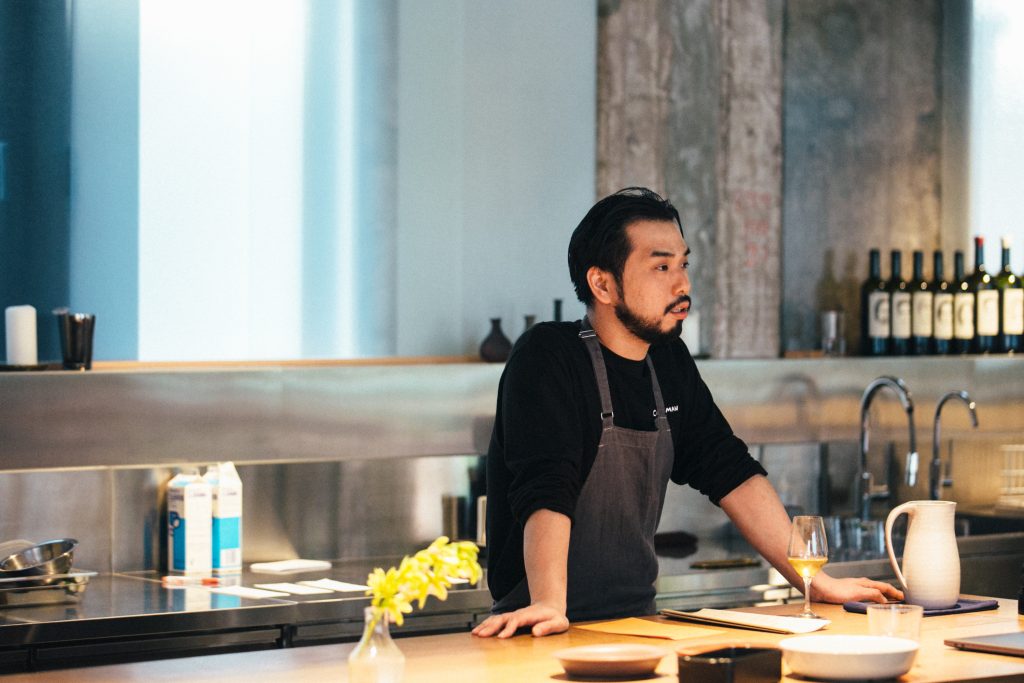
Atsuki Kuroda
Born in Osaka in 1990.
After gaining experience at one of the most renowned Italian restaurants in Japan, Ponte Vecchio, he moved to Italy. After experiencing authentic Italian cuisine, he discovered New Nordic Cuisine and made a new base in Scandinavia. In Oslo, Norway, he worked as a sous chef at Maaemo, at the time, a three-star Michelin restaurant. Since returning to Japan, he has been working as the owner-chef of the restaurant “caveman” in the micro complex K5 Hotel, located in Nihonbashi Kabuto-cho. His ultimate goal is to open an auberge in the future.
Text : Jun Kuramoto
Photo : Naoto Date
Interview : Akihiro Matsui
Atsuki Kuroda
Owner-chef, caveman
Mr. Hiroki Yamamichi
President of Tokyo Stock Exchange, Inc.
Interesting people in Kabutocho
Mr. Yamamichi, who took over as president on April 1st, was previously the president of the Osaka Securities Exchange (OSE), and in fact the restaurant I used to work in, Ponte Vecchio, was located underneath the OSE. It’s such a coincidence that I happen to be working near the stock exchange where Mr. Yamamichi is based, so I’d like to talk to him!
